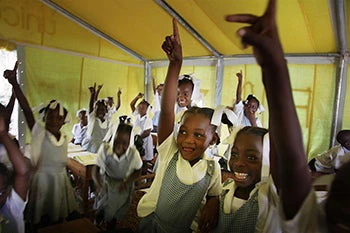
And yet, schools continue to be destroyed when disasters strike – putting children at risk and disrupting education.
Why? Simply put, countries face a number of technical challenges to make their schools resilient. And I saw it firsthand during a visit to Mozambique, where lack of capacity hampered the government’s efforts to build safer schools. A few years back the Ministry of Education introduced a new form of school construction, involving a pre-fabricated steel frame. While in theory this technique makes construction faster and structures more reliable in the event of a disaster, reality is more complicated. The skilled labor required to use the steel frames was not always available, sometimes resulting in delays and additional costs in remote areas.
Another common challenge relates to the availability of risk information needed to identify safe locations where new schools can be built. In Indonesia for example, local communities are typically in the lead when it comes to deciding where a school will be built. And if they are not aware of potential hazards, they will likely decide to build schools on marginal lands with low economic value which are often highly exposed to hazards, such as flooding and landslides.
But these technical challenges only tell part of the story. Things become more complex when we factor in political incentives. Population growth and progress towards universal primary and secondary education have put pressure on decision makers to step up the construction of new schools. Because success is often measured in terms of number of classrooms, quantity is sometimes favored over quality, skewing incentives toward unsafe building practices. Likewise, improving the safety of existing schools can be a costly investment, and therefore a difficult decision.
Finally, without adequate procedures, human resources, and financing for building code enforcement, it is difficult to ensure that schools are actually built to code.
The Global Program for Safer Schools, an initiative of the Global Facility for Disaster Reduction and Recovery, supports countries to overcome these challenges through technical assistance directly related to large-scale school construction and retrofitting projects.
The premise behind this approach is simple: despite an increasing focus on school infrastructure safety, national governments and development partners have not managed to address the problem at scale, with few exceptions. By providing technical assistance in ongoing and planned projects, the program makes sure governments take charge of the initiative and helps them deliver on the goal of disaster resilient schools in a cost-effective way.
To date, the program has started activities in El Salvador, Nepal, Mozambique, the Philippines, and Peru, and will expand to Armenia, Indonesia, Jamaica, the Pacific, and Turkey in 2016. At the same time, the program supports country-to-country learning and knowledge exchanges. This year, the Program, in collaboration with the GFDRR Tokyo Hub, organized a technical workshop which brought together experts to discuss the building blocks of successful school safety interventions.
In some countries, like Mongolia, these activities focus on analytics to identify schools at risk and prioritize risk reduction investments in the education sector.
In Peru, a GFDRR-supported risk assessment in Lima and Callao indicated that the Ministry of Education can reduce about 70% of the seismic risk by improving the physical safety of 600 schools – 30% of all schools. The government has started the implementation of the first phase of Plan Lima, which includes making 373 of the most vulnerable schools resilient, benefitting 278,000 students. This approach is progressively being expanded to the national level: in the medium to long-term, some 12,000 schools across Peru are expected to be made resilient.
The program has also been active in the aftermath of disasters. In Nepal, it has been providing technical advice and support to the Department of Education to inform the reconstruction process following the April 2015 earthquake. A comprehensive structural integrity and damage assessment will be finalized this month and will inform a prioritized investment plan for reconstruction and retrofitting. In addition, the program will provide options to make sure the new schools built in the country are more resilient to disasters.
Since the safety of school infrastructure is only one part of a comprehensive approach to school safety, the program closely coordinates with other development partners, such as UNICEF, UNESCO, UNISDR, Save the Children and Plan International, to ensure that the improvement of the infrastructure is complemented by preparedness activities and other efforts to build a culture of safety.



Join the Conversation